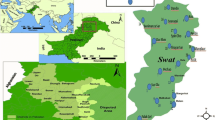Summary
Increment borer samples taken at breast height in Pilgerodendron uviferum (Cupressaceae) trees growing in two Chilean forest stands near latitude 42° south were used to study growth rates in diameter, basal area, and height. Radial average growth is 0.51 mm/year in Santa Luciă 0.44 mm/year in the Piuchué stand; the correlation between diameter and age is 0.79 in Santa Lucía and 0.64 in Piuchué. Similar results were obtained in the basal area/age relationship. Both groups of trees have a low rate of growth compared to rates obtained in other studies. Maximum values for radial growth (culmination age) are reached at 110 years of age in Santa Lucia and 50 years in Piuchue. Growth in height, averaging 5.8 cm/year, appears to be similar in all trees analyzed; occasional differences can be attributed to understory position of some trees. Comparison of radial growth and germination of Pilgerodendron plants shows a synchronous relationship, suggesting an influence of climate on the pattern of forest regeneration.
Similar content being viewed by others
References
Assmann E (1970) The principles of forest yield study. Pergamon, Oxford
Baas P, Schmid R, Heuven BJ van (1986) Wood anatomy of Pinus longaeva (bristlecone pine) and the sustained length-on-age increase of its tracheids. IAWA Bull 7: 221–228
Cook ER (1985) A time series analysis approach to tree-ring standardization. Tree Ring Laboratory, Lamont-Doherty Geol Observ, Palisades, N. Y.
Cook ER, Peters K (1981) The smoothing spline: a new approach to standardizing forest interior tree-ring width series for dendroclimatic studies. Tree-Ring Bull 41: 45–53
Dansereau P, Segadas-Vianna F (1952) Ecological study of the peat bogs of eastern North America. I. Structure and evolution of vegetation. Can J Bot 30: 490–520
Fritts HC (1976) Tree rings and climate. Academic Press London
Holmes RL (1983) Computer-assisted quality control in tree-ring dating and measurement. Tree-Ring Bull 43: 69–75
Holmes RL, Adams RK, Fritts HC (1986) Tree-ring chronologies of western North America: California, eastern Oregon and northern Great Basin. Chronology Series VI. Laboratory of Tree Ring Research, Tucson, Ariz.
Kalela EK (1941) Über die Entwicklung der herrschenden Bäume in den Beständen verschiedener Waldtypen Ostpatagoniens. Ann Acad Sci Fenn Ser A 4: 3
Martinez Miranda O (1981) Flora y fitosociología de un relicto de Pilgerodendron uvifera (D. Don) Florin en el fundo San Pablo de Tregua (Valdivia-Chile). Bosque 4: 3–11
Miller A (1976) The climate of Chile. In: Schwerdtfeger W (ed) Climates of Central and South America. Elsevier, Amsterdam, pp 113–145
Moore DM (1983) Flora of Tierra del Fuego. Nelson, London
Payette S (1976) Succession écologique des forêsts d'épinette blanche et fluctuations climatiques, Poste-de-la-Baleine, Nouveau-Québec. Can J Bot 54: 1394–1402
Robinson WJ, Evans R (1980) A microcomputer-based tree-ring measuring system. Tree-Ring Bull 40: 59–64
Roig FA (1991) Dendrocronología y dendroclimatología del bosque de Pilgerodendron uviferum (Don.) Florin en su área norte de dispersion. Bol Soc Arg Bot 27: 217–234
Roig FA (1992) Comparative wood anatomy of South American Cupressaceae. IAWA Bull (in press)
Roig FA, Dollenz O, Mendez E (1985) La vegetation de los canales. In: Boelcke O, Moore D, Roig F (eds) Transecta botánica de la Patagonia Austral. CONICET-Instituto de la Patagonia-Royal Society, Buenos Aires, pp 457–519
Sakai A, Yoshida S, Saito M, Soltai SC (1979) Growth rate of spruces related to the thickness of permafrost active layer near Inuvik, Northwestern Canada. Low Temp Sci Ser B 37: 19–32
Schweingruber FH (1988) Tree Rings. Basics and applications of dendrochronology. Reidel, Dordrecht
Smale MC, Kimberley MO (1986) Growth of naturally regenerated tawa and podocarps in unlogged and selectively logged podocarp/tawa forest, Pureora. New Z J For Sci 16: 131–141
Stokes MA, Smiley TL (1968) Introduction to tree-ring dating. University of Chicago Press, Chicago
Wardle P (1963) The regeneration gap of New Zealand gymnosperms. N Z J Bot 1: 301–315
Young SB (1972) Subantarctic rain forests of Magellanic Chile: distribution, composition, and age and growth rate studies of common forest trees. Antarct Res Ser 20: 307–322
Author information
Authors and Affiliations
Rights and permissions
About this article
Cite this article
Roig, F.A., Boninsegna, J.A. & Holmes, R.L. Growth rates in diameter, basal area, and height of Pilgerodendron uviferum; relationship between growth index and germination. Trees 6, 199–203 (1992). https://doi.org/10.1007/BF00224336
Received:
Accepted:
Issue Date:
DOI: https://doi.org/10.1007/BF00224336




